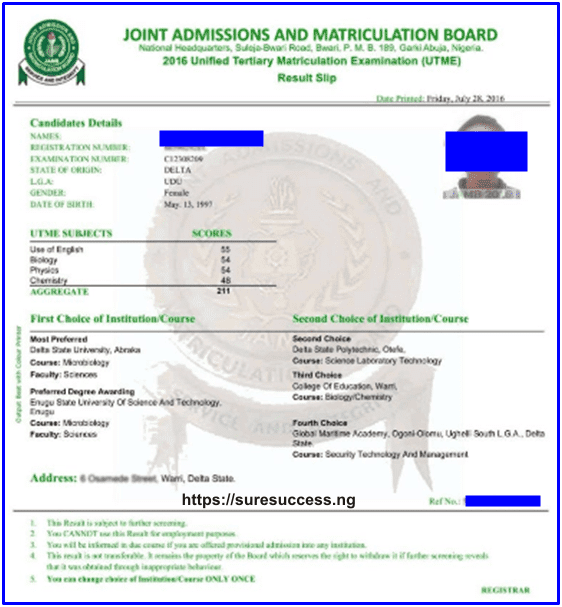The very important question, “How is JAMB score calculated?” has been recurring on different SSNG platforms. Hence, the decision to deal extensively with the subject on this post. My intention is to show you how JAMB score is calculated for Use of English and your other three UTME subject combination. With the information from this post, you will know what to expect after sitting for your JAMB exam.

The word JAMB is an abbreviation for Joint Admissions and Matriculation Board. It is a Nigerian government agency responsible for conducting various examinations in the country.
However, the agency is best known for conducting the Unified Tertiary Matriculation Examination (UTME) for secondary school leavers who intend to further their education.
The UTME is a mandatory examination for candidates who wish to enter into any Nigerian university, polytechnic or college of education. Therefore, it is very important for candidates to know all there is about JAMB examination.
That’s the reason why I’m doing my best on this website to enlighten JAMB candidates on different concepts about the examination. You can get loads of information about JAMB from registration till examination, results and admission on my JAMB Prep and Tutorial Series.
However, I’m going to focus my attention on everything about JAMB score on this post. I’m going to show you how JAMB score is calculated. In so doing, I will answer other questions around the maximum possible score for JAMB and how many marks each question carries. I will also show you how Use of English is different in structure and how to calculate the score.
Table of Contents
Brief Information About JAMB Examination
JAMB organizes the UTME examination as a means of determining to eligibility of candidates for tertiary education.
Over the years, JAMB has been conducting the UTME examination on the CBT mode. So if this happens to be your first attempt, you must bear in mind that you are not going to use paper and pencil for the exam. You will write it on the computer.
JAMB tests aspirants of tertiary institutions on four subjects one of which must be Use of English. So test of Use of English is compulsory for all candidates regardless of their prospective course or institution.
Candidates select their remaining three subject according to the entry requirements of course they wish to study.
Apart from the Use of English paper which consists of 60 questions, every other UTME subject has 40 questions each.
This implies that a typical JAMB examination offers candidates a total of 180 questions which they are expected to attempt within about 3.50 hours.
How Many Marks Does Each Subject Carry in JAMB?
In JAMB examination, each subject carries a total of 100 marks. In other words, each of your four UTME subjects will be marked over 100.
Let’s look at a hypothetical student by name Henry Divine.
Let’s assume that Henry Divine is aspiring for Medicine and Surgery and his JAMB subject combination is Use of English, Biology, Physics and Chemistry.
Henry Divine can get a maximum of 100 marks in each of
- Use of English,
- Biology,
- Physics and
- Chemistry.
Notice that Use of English also has a maximum mark of 100 like the other three despite the fact that it consists of more number of questions. I will show you how to work that out in the coming sections.
Read Also: JAMB Questions and Answers 2022 For All Subjects [FREE Gift]
How Many Marks Does Each Question Carry in JAMB?
We will need to do some simple calculations to arrive at the mark per question for each JAMB subject.
Remember that each JAMB subject carries a total of 100 marks. Therefore,
For Use of English consisting of 60 questions, each question carries (100 ÷ 60) marks or 1.67 marks. So each JAMB Use of English question carries 1.67 marks.
For other subjects consisting of 40 questions each, every question carries (100 ÷ 40) marks or 2.5 marks. So each question in every other JAMB subject, apart from Use of English, carries 2.5 marks.
What is the Maximum Score for JAMB?
The maximum score for JAMB is 400.
You can easily deduce this from the fact the maximum score for each of the four subjects is 100. So if you add the 100 for the four subjects, you get 400.
Read Also: Questions & Answers on The Life Changer JAMB Novel
How to Calculate JAMB Score Per Subject

In this section, I’m going to show you how JAMB score is calculated for your four subject combination. In the first subsection, I will show you how Use of English is structured and how to calculate the JAMB score. Thereafter, I will explain how JAMB score is calculated for your other three subjects.
Use of English Structure / How is JAMB Score Calculated?
JAMB Candidates have to realize that the Use of English exam is different from the other three subjects. Unlike the other subjects, Use of English consists of 60 questions. These 60 questions come under three sections, namely:
- Comprehension/Summary
- Lexis and Structure
- Oral Forms
Here is a breakdown of the sections within the Use of English test.
Section A: Comprehension /Summary
The Section A of Use of English also consists of three components. They include:
- Comprehension Passage
- Passage Text
- Reading Text
The comprehension passage consists of 5 questions, the passage text has 10 questions while the reading text also has 10 questions.
In total, there are 25 questions in the section A of JAMB’s Use of English.
Section B: Lexis and Structure
Section B of Use of English goes with the title Lexis and Structure. The Lexis and Structure section has the following components:
- Sentence Interpretation: there are 5 questions under this.
- Antonyms: there are 5 questions under this.
- Synonyms: there are 5 questions under this.
- Sentence Completion: this part has 10 questions.
Therefore, there is a total of 25 questions in the section B of JAMB’s Use of English.
Section C: Oral Forms
The section C of JAMB’s Use of English is on Oral Forms. There are 10 questions in this section.
The questions in sections A, B and C of Use of English sum up to 60.
Read Also: How You Can Gain Admission With Lów JAMB Score
How is JAMB Score Calculated for Use of English?
So we have seen that JAMB’s Use of English consists of 60 questions. To calculate your score in Use of English, follow the steps below.
To calculate your JAMB score for Use of English, divide your pass score by 60. After dividing your pass score by 60, multiply the result by 100 to obtain your score.
So let’s assume that our hypothetical candidate, Henry Divine scores 42 out of 60 in his Use of English exam.
Here’s how his JAMB score would be calculated:
- Divide his score by 60.
- Multiply the result by 100 to get his final score.
Here’s the working:
42 ÷ 60 = 0.7
0.7 x 100 = 70
Therefore, Henry Divine’s score in use of English is 70.
This means that if he answers all 60 questions correctly, you will score 100.
How is JAMB Score Calculated for Other Subjects?
I will now answer the question, “How is JAMB score calculated for others subjects?”
The procedure is pretty much the same apart from the fact that the other subjects consist of 40 questions each.
To calculate your JAMB score for other JAMB subjects, divide your pass score by 40. After dividing your pass score by 40, multiply the result by 100 to obtain your score.
Let us also assume that our hypothetical candidate, Henry Divine scores 36 out of 40 in any of his other three subjects.
Here’s how his JAMB score would be calculated:
- Divide his score by 40.
- Multiply the result by 100 to get his final score.
Here’s the working:
36 ÷ 40 = 0.9
0.9 x 100 = 90
Therefore, Henry Divine’s score in the subject is 90.
This means that if he answers all 40 questions correctly, you will score 100.
Conclusion of the Article, “How is JAMB Score Calculated?”
So this is where we end this very informative article on how to calculate JAMB score. As you can see from the article, calculating your JAMB score is a straightforward process. If you follow the information in here, you can easily determine your JAMB score as you practice with the Past Questions. That way, you can always monitor your performance even before the main exam.
Since many schools no longer conduct Post UTME screening exam, your JAMB score is now a strong determinant of your admission chances. So it’s a good idea to aim for the highest possible JAMB score in order to increase your admission chances.
Do note that JAMB cut off mark varies every year. Hence, after calculating your total JAMB score, you need to wait to see the JAMB cut off mark to know if you are eligible for admission.
Alright.
Don’t forget that you can use the comments section to ask questions in case there’s something you don’t understand. You can also share your thoughts with me even if you don’t have questions. I’d be glad to hear from you.
Furthermore, kindly help me to reach others with this post. Share with friends on Social Media. Just scroll down to see the Facebook and Twitter and WhatsApp buttons. Thank you so much!
See you on the next article.
Still Got a Question? Drop Your Question Right HERE 👇👇 and click on Search. Get an Immediate Response...
Get in touch with us
Join our FREE 2026 JAMB, WAEC, NECO and BECE Tutorial Classes here: Youtube (Subscribe to the channel)
This is for JSCE, Science and Art Students
If this post was helpful to you, please help us to reach others by sharing with the buttons below!

![How to Write Letter of Undertaking [See Samples]](https://suresuccess.ng/wp-content/uploads/2019/02/letter-of-undertaking-3-310x165.png)
How can a jamb candidate make use of second ,third and fourth choice to secure admission if the first choice institution did not admit him / her.thank you.
The most important thing is to be sure that an institution accepts second, third and fourth choice candidates before choosing them in that regard. For example, most federal universities don’t accept candidates that did not make them their first choice.
If you made the right schools your second, third and fourth choice, your responsibility is to follow the updates from the schools especially after JAMB exams. Know when they release their post utme screening form. Register for the screening, go for the exam if they are conducting one and wait for the release of the admission lists.